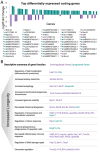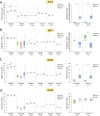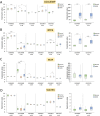Pterostilbene Targets Hallmarks of Aging in the Gene Expression Landscape in Blood of Healthy Rats
- PMID: 39562169
- PMCID: PMC11670294
- DOI: 10.1002/mnfr.202400662
Pterostilbene Targets Hallmarks of Aging in the Gene Expression Landscape in Blood of Healthy Rats
Abstract
Scope: Polyphenols from the phytoestrogen group, including pterostilbene (PTS), are known for their antioxidant, anti-inflammatory, and anti-cancer effects. In recent reports, phytoestrogens attenuate age-related diseases; however, their pro-longevity effects in healthy models in mammals remain unknown. As longevity research demonstrates age-related transcriptomic signatures in human blood, the current study hypothesizes that phytoestrogen-supplemented diet may induce changes in gene expression that ultimately confer pro-longevity benefits.
Methods and results: In the present study, RNA sequencing is conducted to determine transcriptome-wide changes in gene expression in whole blood of healthy rats consuming diets supplemented with phytoestrogens. Ortholog cell deconvolution is applied to analyze the omics data. The study discovered that PTS leads to changes in the gene expression landscape and PTS-target genes are associated with functions counteracting hallmarks of aging, including genomic instability, epigenetic alterations, compromised autophagy, mitochondrial dysfunction, deregulated nutrient sensing, altered intercellular interaction, and loss of proteostasis. These functions bridge together under anti-inflammatory effects through multiple pathways, including immunometabolism, where changes in cellular metabolism (e.g., ribosome biogenesis) impact the immune system.
Conclusion: The findings provide a rationale for pre-clinical and clinical longevity studies and encourage investigations on PTS in maintaining cellular homeostasis, decelerating the process of aging, and improving conditions with chronic inflammation.
Keywords: aging; blood; gene expression; polyphenols; transcriptomics.
© 2024 The Author(s). Molecular Nutrition & Food Research published by Wiley‐VCH GmbH.
Conflict of interest statement
The authors declare no conflict of interest.
Figures






Similar articles
-
Dietary Polyphenols as Anti-Aging Agents: Targeting the Hallmarks of Aging.Nutrients. 2024 Sep 29;16(19):3305. doi: 10.3390/nu16193305. Nutrients. 2024. PMID: 39408272 Free PMC article. Review.
-
Olive Oil and the Hallmarks of Aging.Molecules. 2016 Jan 29;21(2):163. doi: 10.3390/molecules21020163. Molecules. 2016. PMID: 26840281 Free PMC article. Review.
-
New hallmarks of ageing: a 2022 Copenhagen ageing meeting summary.Aging (Albany NY). 2022 Aug 29;14(16):6829-6839. doi: 10.18632/aging.204248. Epub 2022 Aug 29. Aging (Albany NY). 2022. PMID: 36040386 Free PMC article.
-
Polyphenols as Caloric-Restriction Mimetics and Autophagy Inducers in Aging Research.Nutrients. 2020 May 8;12(5):1344. doi: 10.3390/nu12051344. Nutrients. 2020. PMID: 32397145 Free PMC article. Review.
-
Effect of resveratrol and pterostilbene on aging and longevity.Biofactors. 2018 Jan;44(1):69-82. doi: 10.1002/biof.1400. Epub 2017 Dec 6. Biofactors. 2018. PMID: 29210129 Review.
Cited by
-
Association Between Volatile Organic Compounds and Circadian Syndrome Among Pre- and Postmenopausal Women.Toxics. 2025 Apr 23;13(5):328. doi: 10.3390/toxics13050328. Toxics. 2025. PMID: 40423407 Free PMC article.
References
-
- Nishiyama A., Nakanishi M., Trends Genet. 2021, 37, 1012. - PubMed
MeSH terms
Substances
Grants and funding
LinkOut - more resources
Full Text Sources
Medical
Molecular Biology Databases
Research Materials

